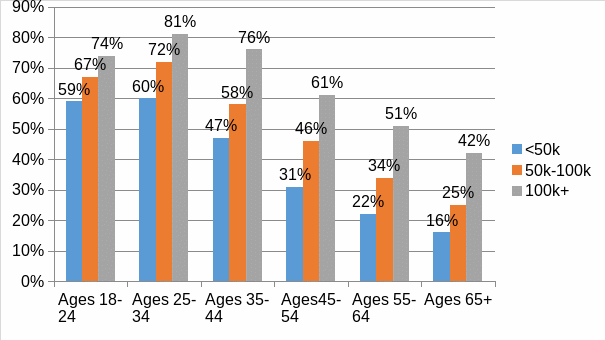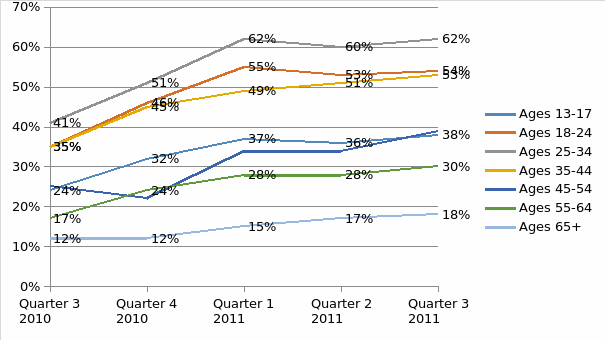Introduction
The Smartphone market has witnessed concerted growth and competition as information technology continues to grow at a fast pace. This dynamic situation has seen Blackberry lose out its long-held global market leadership to new players, including Apple Inc. and Samsung. Blackberry continues to consistently post losses, with its share prices losing value while the management attempts to make drastic decisions to save the once-promising company (Dvorak & Weinberg, 2011, para 1). This report analyses the market segmentation presently adopted in the industry. It also identifies methods adopted by the company in differentiating its service and product ideas from other industry rivals, as well as the targeting strategy used by Blackberry.
Blackberry Target Market Segmentation
Blackberry Target Market: Psychographic Segmentation
Smartphone manufacturers have divided their customers into individual buyers, corporate customers, and government consumers. The individual buyers mainly value basic Smartphone features that include a camera, music players, social networking apps, and other similar features (“IDC: More Smartphones Shipped in Q1 2013 Than Feature Phones” 2013, para 1). The corporate and government customers, on the other hand, value customized software that can enable the employees and customers of specific corporate bodies and agencies to effectively execute roles and acquire services respectively. Financial services groups, including the Wall Street investment banks, form part of BlackBerry’s corporate customers.
Blackberry Target Market: Demographic Segmentation
The Smartphone market has been segmented in terms of age and income size of the targeted buyers. Young consumers between the ages of 18 and 24 are more likely to earn relatively smaller income, thus they will most likely go for Smartphone devices that are cheaper (Blodget, 2012, para 20). On the other hand, youthful consumers between the ages of 25 and 44 are likely to be having higher disposable income because of smaller families, thus they can afford pricey devices with more features and capabilities. In contrast, however, older consumers over 65 years are less likely to spend more on smartphones mostly because of their levels of education and general disinterest in IT. The graph in Appendix 1 highlights the Smartphone penetration in the US in terms of both age and income.
Blackberry Target Market: Geographic Segmentation
Smartphone manufacturers segment the market on the basis of geographic locations as they target the global market. Apple Inc., for instance, mainly targets the developed markets that include the USA, Canada, the UK, and Japan, among other rich countries. It does not concentrate its marketing efforts in the developing markets owing to the low buyer power in these countries (Palenchar, 2009, p. 1). Equally, BlackBerry has also traditionally focused its marketing activities on high-end markets such as North America and Western Europe, while making limited marketing efforts in other developing countries with comparatively low purchasing power (Bellman, 2011, para 3). On the other hand, Nokia and Samsung market their products all over the world where they target to achieve economies of scale advantage. Unlike Apple and BlackBerry, Nokia and Samsung have the low-end products that cost relatively less and affordable even in the developing markets.
Blackberry Strategy: Differentiation
Focused Differentiation
BlackBerry has in the past strictly pursued a focused differentiation strategy in a bid to differentiate itself from other industry rivals. Between 1998 and 2006, BlackBerry manufactured products that were solely targeting business enterprises along with government consumers. The company introduced the BlackBerry Enterprise Server to make the service more unique (“RIM introduces BlackBerry Enterprise Server v4.1”, 2006, p. 1). This platform is unique in the sense that it assures 100 percent secure control of all data flows between the enterprise customer and the server. This has enabled BlackBerry to be renowned as the most convenient, reliable, and safest service provider in the industry.
BlackBerry has managed to build a unique company-CEO infrastructure, established strategic interactions with several of its software developers, as well as various wireless network providers as a result of the focused differentiation.
Broad Differentiation
A change in the company’s differentiation strategy has seen the firm increasingly adopt a broad differentiation approach since 2006. It mainly focuses on a broader consumer array that also includes individual users of handset devices. The new strategy has seen BlackBerry explore products that include casual consumer detailed functions and features. The BlackBerry handsets are based on a unique software platform that supports a unique social community. This is different from the Android platform, for instance, which does not offer any significant security features and capabilities (Moltzen, 2011, p. 1).
Blackberry Pricing Strategy
BlackBerry has traditionally differentiated its products and services on the basis of price. Comparatively, most BlackBerry handsets are sold at a premium price. The company uses this strategy as a means of emphasizing to the market the level of quality that the BlackBerry devices are manufactured with. The market perception that assumes that expensive products are also of higher quality is definitely what BlackBerry appears to target. Compared to other rival players in the market, including Samsung and Nokia, BlackBerry charges comparatively higher prices even for products in the same range as those from rival manufacturers.
Target Customers
BlackBerry is introducing new features and capabilities in its devices to mainly target youthful consumers in a bid to revive its revenues and overall market performance. Trends in the Smartphone industry highlight potential growth capacities, especially among youthful consumers. Most of these users are highly educated and interested in trendy lifestyles and complex IT innovations that provide them with an opportunity to explore their potentials in numerous areas. These consumers also value online social communities and use platforms such as Facebook and Twitter to exchange information and learn about new things.
Youthful consumers between the ages of 18 and 45 have continuously been adopting the use of smartphones between 2010 and 2013 as depicted in the graph in Appendix 2 that highlights the trends in the USA. This trend is set to continue exhibiting the same pattern going forward.
BlackBerry Messenger
Following this trend, BlackBerry has introduced the BlackBerry Messenger (BBM) to try and woe more youthful consumers. The BBM is a social networking application supported on the BlackBerry platform. It works in similar ways as other popular social network platforms, including Facebook and Twitter. In 2011, the BBM platform was ranked as the world’s leading mobile social network in terms of popularity, having had more than 50 million registered users at the time. The application has a worldwide reach, with the users drawn from more than 175 countries. BlackBerry designed a unique platform that, unlike other existing social networking platforms, was less costly because it did not charge for the network service. It also provides more immediacy characteristics as opposed to the emailing services (“Multimedia, Online, Internet; RIM Announces BBM Music – A New Social Music Sharing and Discovery Service”, 2011, p. 616).
Mobile Apps
BlackBerry has targeted to woe youthful customers by venturing into the mobile app business. The firm is mainly considering introducing apps that are more popular among the youthful populations. In 2011, for instance, the company announced a payment app that was supported by the platform, which customers visiting Starbucks outlets would use to make payments (Liddle, 2012, para 1). Given those youthful people also frequent leisure and relaxation joints, such as Starbucks outlets and other restaurant joints, BlackBerry is considering integrating its services with those of such similar restaurant outlets to enhance convenience.
Blackberry Targeting Strategy: Conclusion
The Smartphone industry is mainly segmented on the basis of psychographics and demography where the main targets include government and business enterprise customers, as well as individual users. Demographic segmentation decisions are mainly made in terms of age and income amounts for every potential buyer. BlackBerry has traditionally pursued focused differentiation as a strategy of offering unique products and services to the buyers, which has, in turn, enabled it to build a competitive edge over its market rivals. It mainly targets corporate and government customers and established a unique BlackBerry Enterprise Server to enable it to attain uniqueness. BlackBerry is targeting youthful consumers who are driving Smartphone sales globally by offering the BlackBerry Messenger (BBM) service to enhance online social communities. Unlike in the case of other popular social network platforms, such as Facebook and Twitter, BBM does not charge users for its network services. The company has also ventured into the mobile application business by announcing several apps that mainly target youthful consumers.
List of References
“IDC: More Smartphones Shipped in Q1 2013 Than Feature Phones”, 2013, IDC, Web.
“Multimedia, Online, Internet; RIM Announces BBM Music – A New Social Music Sharing and Discovery Service”, 2011, Telecommunications Weekly, p. 616.
“RIM introduces BlackBerry Enterprise Server v4.1”, 2006, Telecomworldwire, p. 1.
Bellman, E 2011, ‘BlackBerry finds fertile ground in Asia; RIM Turns to Indonesia and other emerging economies as the company’s smartphone loses share in the west’, The Wall Street Journal, Web.
Blodget, H 2012, Actually, the US smartphone revolution has entered the late innings, Web.
Dvorak, P, & Weinberg, S 2011, ‘RIM warns of more BlackBerry blues’, The Wall Street Journal,
Liddle, AJ 2012, ‘Restaurants divided on mobile payments platforms’, Nation’s Restaurant News, Web.
Moltzen, EF 2011, ‘Analysis: The ‘write’ opportunity’, CRNtech, no. 48, pp. 1-15.
Newswire, 2011, Generation App 62% of mobile users 25-34 own smartphones, Web.
Palenchar, J 2009, ‘New iPhones Should Expand Apple’s Share’, TWICE, vol. 24, no. 13, p. 1.
Appendix 1

Appendix 2
